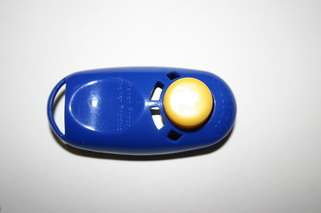By Cheryl Kolus, DVM
Think you can’t train a cat? Think again. We’ve all seen cats on TV or in movies. Do you think those cats have something your cat doesn’t? Probably not. Cat “actors” may be more comfortable than your cat would be in front of all the cameras and lights, but the only other advantage they have is a patient and knowledgeable trainer to work with them. In fact, you can bet that many of those cats you see on film were rescued from a shelter.
You may not envision stardom for your cat, but you can still teach your cat a few tricks and impress your friends and family. Tricks like sit, high-five, come, stay, and jump (on or over something) are relatively easy to teach. You can also use training to decrease unwanted behaviors like jumping on counters or scratching your furniture. Training is fun and will strengthen the bond between you and your feline friend. Patience and a sense of humor are key. Anger and frustration have absolutely no place in training.
CLICKER TRAINING
One great training method used for cats and many other animals is called “clicker training.” This method is often used with performing marine mammals and zoo animals that must learn to accept human handling. It involves using a specific sound IMMEDIATELY after or as the desired behavior is performed. The sound can be a click (purchase a cheap clicker from a pet store or just use a click of your tongue), or it can be a key word (“yes,” “good,” etc.). The trick (for you!) is to make sure you use the same sound or word all the time until the behavior you’re training is reliable.
The idea behind clicker training is that the click (or whatever sound you choose) serves as a “bridge” between the desired behavior and the cat’s reward (after
clicking, you’ll give your cat a food treat). So the order of go is:
(1) The desired behavior occurs, (2) you click and (3) you give
your cat a reward.
The reason for having a bridge is simply that animals live in the present. To make it easy for them to learn, we must let them know RIGHT AWAY when they do a good thing. Say your cat sits. In the seconds it takes you to fumble around for
a treat to reward her for the sit, your cat may have turned her head to look out the window. For all she knows, turning her head is what got her the reward, not sitting. Eliminate that confusion by clicking the moment her butt hits the floor.
Of course, clicking in itself is not a particularly motivating reward for your cat. So now you must link the click with the treat. With cats, we can create this association at the same time that we teach them their first trick, as explained below.
TARGETING AND LOADING THE CLICKER
Targeting simply means having the cat touch its nose to an object, or “target.” Loading the clicker means teaching the cat that a “click” means a treat is coming. We’re going to put the two together. Kitty will learn her first new behavior at the same time she learns what the clicker signifies.
Remember, the click is used to mark the desired behavior and indicate that a reward is coming.
Choose a target. You can buy a “target stick” online but that’s not necessary. Your target could be a pencil or pen, a wooden spoon, or the wand from an old wand and feather cat toy. It could also be a lid from a coffee can or something similar.
In a quiet room with few distractions, hold the target about an inch away from your cat’s nose. Most cats will be curious and want to sniff it. The second her nose touches the target, click and treat (C/T). Do this several times in a row. Some cats will get the idea in just a few trials that touching the target means a click and then a treat. Others may take several days of a few practice sessions a day. Keep sessions short, maybe 5-10 tries at a time, so Kitty doesn’t get bored. If she’s not interested in touching the target, try dipping it in tuna juice or spraying it with catnip. If needed, you can also click for almost touching the target at first, and then after a few times, wait for an actual touch before the C/T
MORE TARGETING
After Kitty figures out that touching the target means a C/T, start making the behavior a little more challenging. Work in small steps to encourage success. At this point, you can also add a cue word, such as “touch” or “target” a second before you present the target. Move the target far enough away that she has to stretch her neck out to touch it. After a few times doing that, move it even farther so that she has to take a step toward it, then a few steps. Then try moving it to the side or above her. You get the idea. Just remember not to make things too difficult too soon as she’s learning this new game. Eventually, you can have Kitty running across the room to touch the target, or use it to teach her to heel beside you or jump onto a chair, or even have her touch other objects.
GO TO MAT
After Kitty’s got targeting down, the next trick many cat trainers teach is “go to your mat.” Having your cat go to his bed or a mat on cue can be a very useful behavior. For instance, it can help keep him from running out the door or jumping on counters while you’re busy in the kitchen. To train this behavior, we’ll use shaping. This means we’ll reward small steps on our way to getting the complete
behavior of sitting or lying on the mat. To start, lay the mat on the floor in front of you. C/T any interaction the cat has with the mat. C/T each of the steps below about 3-4 times before holding out for the next step. If Kitty understands clicker training, he should start trying new things when the previous behavior no longer gets him a reward. In other words, after being C/T’d for sniffing the mat a few times but not the next time, he should try something else like touching it with his paw. Try the following steps, but note that some cats might move along more quickly or may throw some unclickable behaviors in there, too (such as meowing or pawing at you). In the latter case, just ignore that behavior and wait him out. (1) sniff the mat, (2) one foot on the mat, (3) two feet on the mat, (4) all four feet on the mat, (5) sit on the mat, (6) lie down on the mat
These steps can take several sessions. Be patient. Your kitty is learning how to learn, or rather learning how to get you to C/T! Each time you start a new training session, reward a step or two earlier than when you last left off. For instance, if the last session ended when he put all four feet on the mat, start this session by C/Ting a few times for one or two feet on the mat again. Add a cue word or phrase once you’re sure he’ll do the complete behavior. We don’t want him to learn to ignore the cue simply because he doesn’t know the behavior yet.
If Kitty is having a hard time and won’t interact with the mat, or it’s taking a long time to progress through the steps, you can use your target to lure him toward or onto the mat. However, be sure to click when he touches the mat but ideally before he touches the target (and remove the target out of his reach before he touches it). We’re using the target as a lure, but the behavior we’re rewarding is touching the mat. Only use the target 2-3 times before trying again to shape the behavior without it.
TREATS AND TRAINING TIPS
Training should last only a few minutes at a time. To speed up progress, do short training sessions several times a day. But also keep in mind how many food treats your cat is getting, and adjust her diet accordingly if necessary. Initially, treats should be of high value, something your cat really loves but doesn’t get very often. They could be small pieces of tuna, deli meat, boiled chicken, canned cat food, baby food (with no onions or garlic), etc. Some cat trainers swear by bonita flakes, which you can find at some pet stores. Once Kitty is a seasoned clicker cat, you can probably get by using her regular kibble. If your cat is currently free-fed, it may help her motivation to switch to meal feeding. Talk to your veterinarian about healthy treats and a good diet for your kitty in training.



